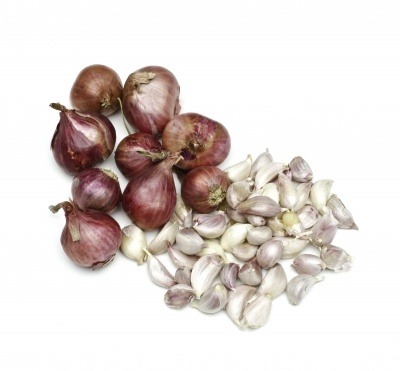
What is Allicin ?
Allicin (IUPAC name: S-Prop-2-en-1-yl prop-2-ene-1-sulfinothioate or to some, 2‐propenyl‐2‐propene‐thiosulphinate) is a key biologically important compound found in garlic which is a signature species in the Onion family, Alliaceae. For many garlic is a very important food ingredient and the basis for traditional and modern medicine (Wang et al., 2011; Martins et al., 2016).
It is notable as an organo-sulphur compound which was first identified by Cavallito and Bailey in 1944. Crushing and chopping garlic releases an enzyme called allinase that converts alliin ((+)‐S‐2‐propenyl‐L‐cysteine‐S‐oxide) into allicin that then produces the characteristic sulphurous aroma of fresh garlic (Brodnitz et al., 1971).
Alliin is the main flavour precursor of allicin which is why there is so much interest in developing cultivars with a high content of this compound.
Once released from its cellular compartments, allicin has a short-shelf life because it is highly unstable and then converted into so many other highly-active sulphur compounds. These are all volatile sulphides which are mainly 2‐propenyl (allyl) derivatives (Avato et al., 2000). Notable reaction products are diallyl disulphide, diallyl disulphide and diallyl trisulphide (Naganawa et al., 1996; Kim et al., 2004; Avato et al., 2000).
The Power Of Allicin As An Antimicrobial.
Allicin is currently being investigated for its activity against bacterial infections that show multiple drug resistance (Ankri & Mirelman, 1999). It is also active against certain fungal and viral infections when in vitro. We know allicin is part of the defence mechanism against attacks by pests especially fungi and various soil derived pathogens on the garlic plant.
The antimicrobial power of allicin resides with the disulphide bond. The compound is highly active against the following bacteria:- B. cereus, Cl. botulinum, E. coli, Lb plantarum, L. monocytogenes, P. auroginosa, S. typhymurium and S. aureus (Naganawa et al., 1996; Rattanachaikunsopon & Phumkhachorn, 2008; Fujisawa et al., 2009; Pirak et al., 2012; Fratianni et al., 2016).
Products

Garlic incidentally is also one of the richest sources of polyphenols which have considerable health properties in their own right.
References
Ankri, S., & Mirelman, D. (1999). Antimicrobial properties of allicin from garlic. Microbes and Infection, 1(2), pp. 125-129
Avato, P., Tursi, F., Vitali, C., Miccolis, V. & Candido, V. (2000). Allylsulfide constituents of garlic volatile oil as antimicrobial agents. Phytomedicine, 7, pp. 239–243.
Brodnitz, M.H., Pascale, J.V., Derslice, L.V. (1971). Flavor components of garlic extract. J. Agric. Food Chem. 19 (2) pp.273–5 doi:10.1021/jf60174a007
Cavallito, C. J., & Bailey, J. H. (1944). Allicin, the antibacterial principle of Allium sativum. I. Isolation, physical properties and antibacterial action. J. American Chemical Society, 66(11), pp. 1950-1951
Fratianni, F., Ombra, M.N., Cozzolino, A. et al. (2016). Phenolic constituents, antioxidant, antimicrobial and anti‐proliferative activities of different endemic Italian varieties of garlic (Allium sativum L.). Journal of Functional Foods, 21, pp. 240–248 https://doi.org/10.1016/j.jff.2015.12.019 .
Fujisawa, H., Watanabe, K., Suma, K. et al. (2009). Antibacterial potential of garlic‐derived allicin and its cancellation by sulfhydryl compounds. Bioscience, Biotechnology, and Biochemistry, 73, pp. 1948–1955 https://doi.org/10.1271/bbb.90096
Kim, J.W., Jung, E.H., Kyung, S.H. & Kyung, K.H. (2004). Antimicrobial activity of alk(en)yl sulfides found in essential oils of garlic and onion. Food Science and Biotechnology, 13, pp. 235–239
Martins, N., Petropoulos, S. & Ferreira, I.C.F.R. (2016). Chemical composition and bioactive compounds of garlic (Allium sativum L.) as affected by pre‐ and post‐harvest conditions: A review. Food Chemistry, 211, pp. 41–50 https://doi.org/10.1016/j.foodchem.2016.05.029
Naganawa, R., Iwata, N., Ishikawa, K., Fukada, H., Fujino, T. & Suzuki, A. (1996). Inhibition of microbial growth by ajoene, sulfur‐containing compound derived from garlic. Applied and Environmental Microbiology, 12, pp. 4238–4242
Pirak, T., Jangchud, A. & Jantawat, P. (2012). Characterisation of physical, chemical and antimicrobial properties of allicin‐chitosan complexes. International Journal of Food Science and Technology, 47, pp. 1339–1347 https://doi.org/10.1111/j.1365-2621.2012.02978.x .
Rattanachaikunsopon, P. & Phumkhachorn, P. (2008). Diallyl sufide content and antimicrobial activity against food‐borne pathogenic bacteria of chives (Allium schoenoprasum). Bioscience, Biotechnology and Biochemistry, 72, pp. 2987–2991.
Wang, J., Cao, Y.P., Sun, B.G. & Wang, C.T. (2011). Physicochemical and release characterisation of garlic oil‐b‐cyclodextrin inclusion complexes. Food Chemistry, 127, pp. 1680–1685. https://doi.org/10.1016/j.foodchem.2011.02.036
Leave a Reply